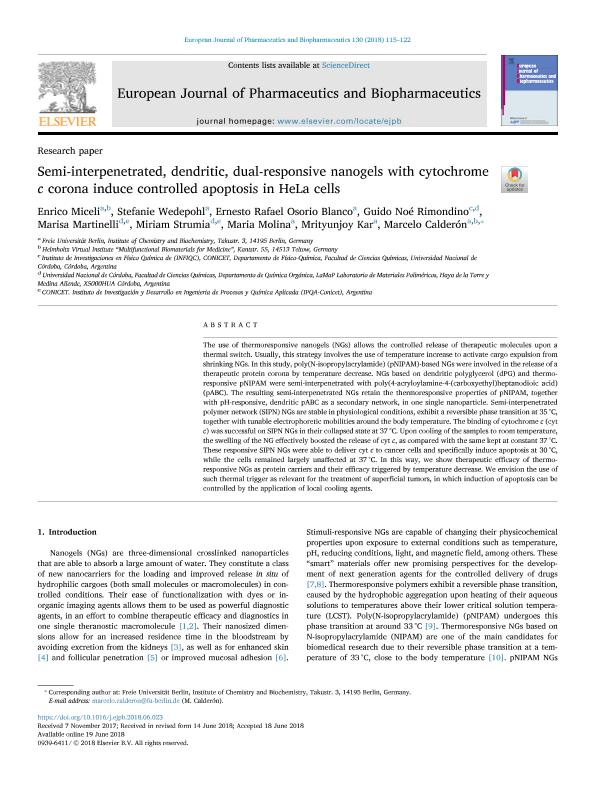Artículo
Semi-interpenetrated, dendritic, dual-responsive nanogels with cytochrome c corona induce controlled apoptosis in HeLa cells
Miceli, Enrico; Wedepohl, Stefanie; Osorio Blanco, Ernesto Rafael; Rimondino, Guido Noé ; Martinelli, Marisa
; Martinelli, Marisa ; Strumia, Miriam Cristina
; Strumia, Miriam Cristina ; Molina, Maria; Kar, Mrityunjoy; Calderon, Marcelo
; Molina, Maria; Kar, Mrityunjoy; Calderon, Marcelo
 ; Martinelli, Marisa
; Martinelli, Marisa ; Strumia, Miriam Cristina
; Strumia, Miriam Cristina ; Molina, Maria; Kar, Mrityunjoy; Calderon, Marcelo
; Molina, Maria; Kar, Mrityunjoy; Calderon, Marcelo
Fecha de publicación:
09/2018
Editorial:
Elsevier Science
Revista:
European Journal Of Pharmaceutics And Biopharmaceutics
ISSN:
0939-6411
Idioma:
Inglés
Tipo de recurso:
Artículo publicado
Clasificación temática:
Resumen
The use of thermoresponsive nanogels (NGs) allows the controlled release of therapeutic molecules upon a thermal switch. Usually, this strategy involves the use of temperature increase to activate cargo expulsion from shrinking NGs. In this study, poly(N-isopropylacrylamide) (pNIPAM)-based NGs were involved in the release of a therapeutic protein corona by temperature decrease. NGs based on dendritic polyglycerol (dPG) and thermoresponsive pNIPAM were semi-interpenetrated with poly(4-acryloylamine-4-(carboxyethyl)heptanodioic acid) (pABC). The resulting semi-interpenetrated NGs retain the thermoresponsive properties of pNIPAM, together with pH-responsive, dendritic pABC as a secondary network, in one single nanoparticle. Semi-interpenetrated polymer network (SIPN) NGs are stable in physiological conditions, exhibit a reversible phase transition at 35 °C, together with tunable electrophoretic mobilities around the body temperature. The binding of cytochrome c (cyt c) was successful on SIPN NGs in their collapsed state at 37 °C. Upon cooling of the samples to room temperature, the swelling of the NG effectively boosted the release of cyt c, as compared with the same kept at constant 37 °C. These responsive SIPN NGs were able to deliver cyt c to cancer cells and specifically induce apoptosis at 30 °C, while the cells remained largely unaffected at 37 °C. In this way, we show therapeutic efficacy of thermoresponsive NGs as protein carriers and their efficacy triggered by temperature decrease. We envision the use of such thermal trigger as relevant for the treatment of superficial tumors, in which induction of apoptosis can be controlled by the application of local cooling agents.
Archivos asociados
Licencia
Identificadores
Colecciones
Articulos(INFIQC)
Articulos de INST.DE INVESTIGACIONES EN FISICO- QUIMICA DE CORDOBA
Articulos de INST.DE INVESTIGACIONES EN FISICO- QUIMICA DE CORDOBA
Articulos(IPQA)
Articulos deINSTITUTO DE INVESTIGACION Y DESARROLLO EN INGENIERIA DE PROCESOS Y QUIMICA APLICADA
Articulos deINSTITUTO DE INVESTIGACION Y DESARROLLO EN INGENIERIA DE PROCESOS Y QUIMICA APLICADA
Citación
Miceli, Enrico; Wedepohl, Stefanie; Osorio Blanco, Ernesto Rafael; Rimondino, Guido Noé; Martinelli, Marisa; et al.; Semi-interpenetrated, dendritic, dual-responsive nanogels with cytochrome c corona induce controlled apoptosis in HeLa cells; Elsevier Science; European Journal Of Pharmaceutics And Biopharmaceutics; 130; 9-2018; 115-122
Compartir
Altmétricas



